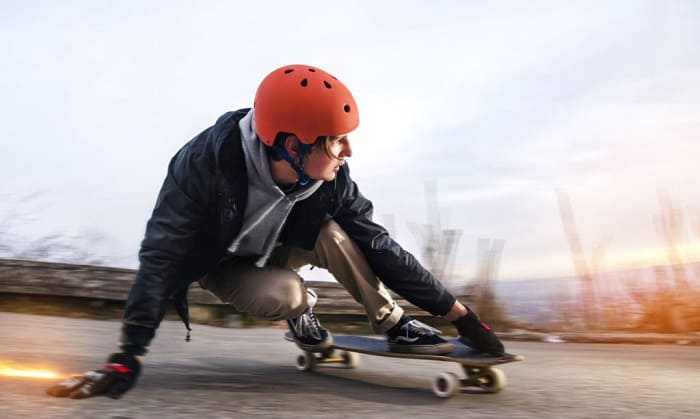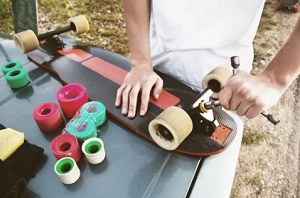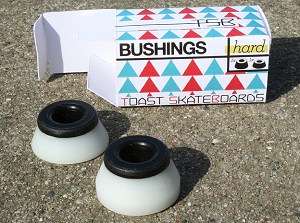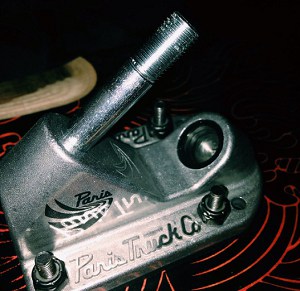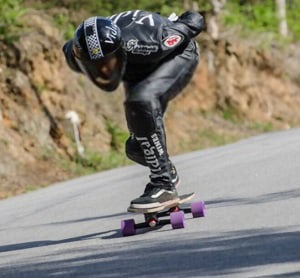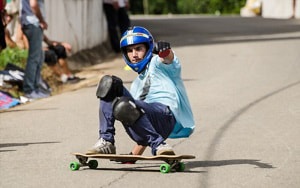At least once in your skating journey, you dreamt of riding fast. It could be because you found the idea thrilling or love the thought of arriving at your destinations quickly.
However, speed also entails risks, especially when skating downhill. One of these hazards could be accidents brought about by a shaky skateboard traveling fast. But the good news is, these problems are controllable.
With that, let’s discuss how to deal with speed wobbles skateboard riders encounter on the road. Here, we’ll learn about safety precautions and necessary movements to counter unstable, speedy skate rides.
Table of Contents
Ways to Control Speed Wobbles on a Longboard
To give you an overview of the remedies we’ll perform, take note of the following:
- Adjusting the truck’s tightness
- Installing the right bushings
- Moving the right way
- Having the right position
- Distributing your weight
- Slowing down
What to prepare
As you notice, most of the procedures we’ll do to prevent speed wobble only revolve around us and the skateboard. So, we don’t need many things.
- T-tool – T-tools are a universal skating staple because of their comprehensive functionality. Included are socket wrenches, an Allen wrench, and a Phillips head screwdriver.
Should you not have a T-tool, prepare a hexagon socket, a hand wrench, and a screwdriver for the kingpin and truck mounts.
- Bushings – Part of the skateboard trucks are bushings, which are replaceable components that are necessary to stop wobbling on a skateboard.
Generally, the heavier a skater is, the stiffer the bushings should be. For example, if the rider weighs at least 195lbs, 100a bushings shall be the best option.
Detailed Steps to Dealing With Skateboard Speed Wobbles
Now that we have all the things necessary, it’s time to get into these methods and practice applying them.
Step 1: Adjusting the truck’s tightness
The only way to tighten or loosen the skateboard’s trucks is through their kingpins. These are thick, long bolts rooting from the baseplate and piercing through the hanger.
Begin by aligning the kingpin’s tip to the slot in the wrench.
To tighten the truck, rotate the skate tool or socket’s handle clockwise. Do it gradually in quarter turns as you aim for optimum tightness.
Note that the front and back trucks’ tightness should be the same. Otherwise, there is a higher chance the skateboard drives off-direction where the skate truck is loose.
So, try to rock both trucks in between adjustments to assess if they have the same tightness level. Keep tightening these parts until they’re stiff enough to turn when skating.
Step 2: Installing the right bushings
As mentioned, we need hard bushings to restrict the trucks from pivoting too much.
So, let’s begin the installation process by pulling out the old bushings. Using your T-tool or wrench, loosen the nuts of the trucks’ kingpins. Pull the first bushing out, followed by the hanger and the second bushing.
And since you only have the baseplate and kingpin left mounted on the deck, you might as well try to clean all the truck’s parts. That way, you ensure neatness and longer service lives for these components.
Suppose you cleaned the trucks’ components. Follow this sequence from the baseplate as you install your new bushings
- Large washers
- Large bushings
- Hangers
- Small bushings
- Small washers
Finally, adjust the tightness of the trucks to a stable and less shaky level.
Step 3: Moving the right way
If skateboard parts have standard specifications, skaters should also execute movements the right way. To get rid of speed wobbles, we should hit the perfect stance and control the board effectively. Let’s dig deeper into these methods.
- Having the appropriate position
When skating downhill, we assume a specific position to help distribute our weight over the skateboard. And for purposes of discussion, we’ll call this position the Speed Tuck.
In this method, we only need to get used to tucking in and balancing when going down a slope. A parking lot or an open space will do in this instance.
So, begin by putting your skateboard on a flat surface. Step on the front part of the deck with your dominant foot. Your shoe should be slightly diagonal over the width of the deck, and the tip should point to the front truck bolts.
Next, place your rear foot behind the front one with the heel pointed to the rear truck bolts.
Bend your knees as you lower and lean your upper body slightly forward. Your front leg should bend at 90°, and your back knee must rest on your front leg’s calf.
Tuck your body in as you rest your chest on your front leg and knee. Lock your hands behind your butt. Keep your eyes forward as if you’re checking your downhill path.
- Distributing your weight
Even when skating in a straight direction, we can still fall off balance because of leaning too much to one side. Knowing how to distribute your weight on the board will solve the problem.
As a general concept, we should put 60% of our weight in front of the skateboard and 40% at the back. And while we cannot quantify the amount of weight to distribute on either end of the skateboard, remember not to put most of your weight on the back trucks.
- Slowing down
Perhaps, slowing the skateboard down is a solution to a longboard speed wobble. So, we might as well learn two ways to do it: the controlled slide and foot brake.
A controlled slide happens when we turn the skateboard sideways. This move is possible whether riding on a straight path or one with a curved end. All we need to do is make a 180-degree turn and bend our knees while keeping our feet on the board.
On the other hand, the foot brake is a straightforward technique. Here, we only use our back foot to act as the brake. To do it, lightly slide the rear foot against the ground as friction increases. From there, the skateboard will begin to slow down.
As soon as you’re confident about bringing the board to a complete stop, you may press your back foot firmly against the ground to stop the motion.
Other Helpful Tips
Besides the technical aspects I shared, you may also consider the following tips as you avoid speed wobbles.
- Move with confidence
- Relax and keep your knees bent
- Try low-angled trucks
Conclusion
Skateboards and longboards are fun ways to enjoy scenic views and downhill rides. But without the appropriate configuration of these tools, we become more exposed to accidents.
Especially when skating downhill fast, not having the best skateboard setup is risky. But now that you know how to deal with speed wobbles skateboard users encounter, the hazards are finally manageable.
So, always remember to distribute your weight on the board, use the most accurate parts, and adjust what needs adjustment. That way, you’re more likely to achieve safe and stable rides.

Hi, I am Charles Harris. I opened this site to write as much as I can about my biggest passion – skateboarding!
I started as a clumsy yet passionate rookie 10 years ago to now a still passionate yet much better skateboarder! But I have to tell you, the whole journey has always been fun and rewarding, indeed not without hardship.


